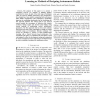826 search results - page 13 / 166 » Emotion Based Control Architecture for Robotics Applications |
ICRA
2005
IEEE
14 years 1 months ago
2005
IEEE
— When industrial robot arms are controlled using sensor data the performance is dependent on the sensor sampling rate, on delays in signal processing, and on the robot dynamics....
AROBOTS
2007
13 years 7 months ago
2007
This research details the application of non-verbal communication display behaviors to an autonomous humanoid robot, including the use of proxemics, which to date has been seldom ...
CIMCA
2006
IEEE
14 years 1 months ago
2006
IEEE
This work is dedicated to position control of redundant robots, realized with the help of the sensibility theory. The control method allows controlling the robot position followin...
ECAL
2001
Springer
2001
Springer
A Visually-Based Evolvable Control Architecture for Agents in Interactive Entertainment Applications
13 years 12 months ago
A visually-based evolvable control architecture for agents in interactive entertainment applications is presented. Agents process images of their local surroundings according to ev...
CEC
2007
IEEE
14 years 1 months ago
2007
IEEE
—The purpose of this paper is to present a comparison between two methods of building adaptive controllers for robots. In spite of the wide range of techniques which are used for...

